Under the Surface
A Linguistic Analysis of German’s Hidden Word Order

This paper explores the contrast between German’s surface level and deep structure level word order within the context of generative grammar. A basic background in the linguistic branch of syntax is introduced along with an explanation of the theory of generative grammar which is necessary for understanding the core of the analysis. A guided examination of phrase structure and transformation rules is first given in English, and later in German. Syntax trees also appear as an illustration of the syntactic rules for various examples throughout the paper. Subject, verb, object word order in English is clarified. How German word order could be subject, object, verb is explored within the first half of the paper. Moreover, important distinctions between main clauses and embedded clauses are clarified within English for easy understanding, as German embedded clauses become the focus of the argument in the second half of the paper. Essential syntactic rules are then constructed for German’s embedded clauses, along with transformation rules that portray movement of verbs and phrases to form yes-no questions and simple declarative sentences. Using this as evidence, an argument asserting that German’s deep structure originates from embedded clauses, which have a strikingly different word order than German’s main clauses, is articulated.
Keywords: generative grammar, phrase structure, surface/deep structure, embedded clause, movement transformation
German is the official language of six countries in Europe and is spoken by nearly one hundred million people worldwide (Fagan 2009). Both English and German are members of the West Germanic language family which suggests that they both derive from an earlier language known as Proto-Germanic. They share similar characteristics such as conjugation patterns in certain verbs in the past tense and parallels in adjective patterns like rich, richer, richest (Germanic Languages 2020). However, despite being a part of the same language family and having seemingly similar characteristics of grammar, English and German are quite distinct when it comes to their individual word order.
To understand these more complex grammatical differences between English and German, the concept of generative syntax must be understood. Syntax is a branch of linguistics that aims to explain how sentences are structured in any given language. There are several different theories that have been proposed by linguists, each providing a different approach to understanding the intricacies of this branch of linguistics. The well-known linguist Noam Chomsky helped pioneer the syntax theory of generative grammar. Generative grammar proposes that sentences are generated by a subconscious set of procedures and that these procedures can be represented with a set of formal grammatical rules (Dikken 2013). These rules then describe how words should be ordered in any given language.
These phrase structure rules can be crafted by examining sentences of any given language and observing the way the words are ordered within. For example, the English sentence in example (1a), shown below, consists of a pronoun, verb, and object.
(1a) I ate the delicious cake.
All of these parts of speech can be used to create a set of phrase structure rules which serves as the foundation to the theory of generative grammar. Noun phrases (NP) can serve as the subject or an object of a sentence and are a phrase that is headed by a noun (N) or pronoun (PN). Within example (1a), I is a PN that is within an NP that is acting as the subject. The delicious cake is also an NP made up of a determiner (D), the, an adjective (A), delicious, and a N, cake. Based on this sentence, an NP rule can be formulated. An NP can either consist of a PN or an optional D and optional A, preceding the main N. Both the D and A are optional, as indicated by the parentheses below, since it is possible to generate the sentence (1b), which does not have a D or A modifying the main noun of cakes.
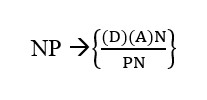
Figure 1. Noun Phrase Structure Rule
(1b) Cakes are delicious.
(1c) I ate.
With regards to a verb phrase (VP) which is seen in example (1a), it is comprised of a verb (V) and an NP which is acting as the object. Thus, it is possible to state that VP → V (NP). The NP is optional in this case because a sentence such as (1c), which does not contain an object NP, is perfectly grammatical.
Looking at the sentence in example (1a) as a whole, there is an NP and a VP. The other examples (1b) and (1c) also consist of an NP and a VP, respectively. Therefore, in English, a sentence (S) must be made up of an NP and VP, formalized as S → NP VP. These phrase structure rules can also be illustrated with syntax trees as shown in figure 2.
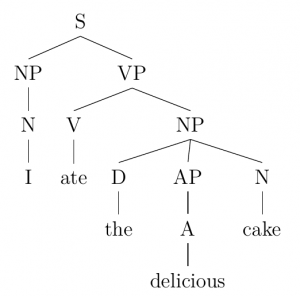
Figure 2. (1a) Syntax Tree
Another important aspect to the theory of generative grammar is the difference between the surface structure and deep structure of a sentence. As discussed in Chomsky’s (1964, 1965) work, Surface structure is said to be the complete grammatical sentence of a language and is derived from the deep structure. Deep structure, on the other hand, is a sentence in its most basic form before any grammatical transformation rules have applied. For example, (2a) shows an active sentence in English while (2b) shows its passive counterpart.
(2a) The boy kicked the ball.
(2b) The ball was kicked by the boy.
Overall, there is no difference in meaning between these two sentences. One is simply active and the other passive. However, in regard to deep structure, the passive sentence is the surface level form that was derived from the active sentence. The transformation rules mentioned previously play a vital role in how a sentence is derived from its deep structure to surface structure, which is considered to be its normal, grammatical form.
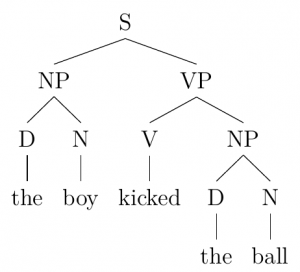
Figure 3. (2a) Syntax Tree
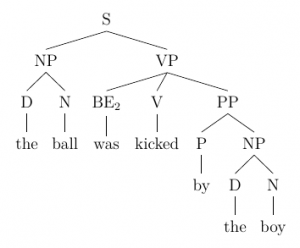
Figure 4. (2b) Syntax Tree
Comparing the active (2a) and passive (2b) syntax trees, there are some distinct connections that can be made. In the original active sentence, there is a subject, the boy, and there is an object, the ball. However, looking at the passive structure, the subject and object have noticeably switched places. The original subject is now within a prepositional phrase (PP) at the end of the sentence and the original object has now fallen into subject position. Moreover, an auxiliary verb (here, BE2)—a special kind of verb that functions grammatically and helps to express aspect, mood, or voice—has been inserted before the main V, kicked. If any active sentence with a direct object is considered, this same set of rules can be applied, and a passive sentence will be formed. Thus, from these individual steps, what is called a transformation rule can be formalized.
(3) Passive: Take a S with a direct object, insert BE2 right before the main V, move the phrase in direct object position into subject position, and move the original subject NP into a by-PP at the end of the VP.
This rule describes the process of deriving a passive sentence’s surface structure which the theory of generative grammar states everyone does in their heads without thought. If the deep structure of a passive sentence is drawn in a syntax tree, these transformation rules can be applied visually. The arrows show where a phrase is moved to and the dashed lines connect a phrase that was not originally present in the deep structure. The outcome after the transformation rules have been applied is the sentence’s surface structure.
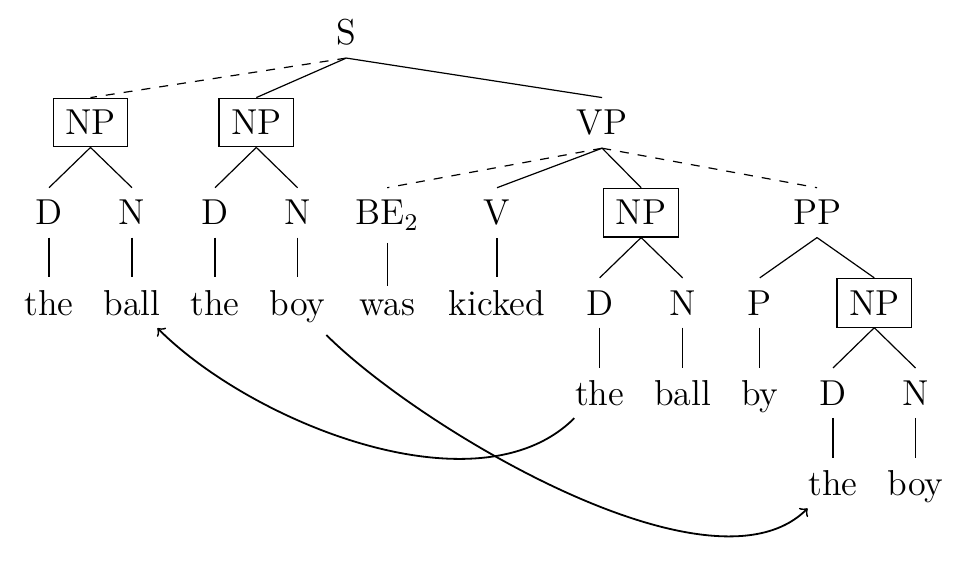
Figure 5. (2a) to (2b) Passive Syntax Tree Breakdown
So far, I have introduced the basics of generative grammar and the methods that are used to establish phrase structure rules and transformation rules. While surface structure and deep structure are important for syntax in any language, it is particularly important in German syntax because of the considerable difference between German’s surface level word order and its deep structure word order (Vickner 1995). English is an SVO language, meaning the subject, verb, and object mostly stay in this specific order except in special cases, such as questions. On the surface, German often appears to be an SVO language as well. However, the deep structure of German tells quite a different story.
Sentences always contain an independent clause and sometimes a dependent clause. The independent clause of a sentence is simply a clause that has a subject and predicate and can stand alone as its own sentence. A dependent clause provides additional information to the independent clause but cannot stand alone as its own sentence.
(4a) She is a teacher.
(4b) I know that she is a teacher.
The example (4a) is an independent clause consisting of a subject, she, and a predicate, is a teacher. (4b), on the other hand, has an independent clause, I know and a dependent clause, that she is a teacher. Dependent clauses are sometimes referred to as an embedded clause because it is embedded within the sentence. Native English speakers will be able to recognize that that she is a teacher is not a grammatical sentence because it needs to be a part of an independent clause.
These sentences that contain an embedded clause can also be accounted for within the phrase structure rules that were used previously. In this case, that which appears in (4a) is referred to as a complementizer (C). The function of a complementizer is to let a clause such as she is a teacher act as the object of the sentence. Thus, a complementizer phrase (CP) can be formed that consists of a complementizer and a sentence which looks like CP → C S. Once again, a change to the verb phrase structure rule is necessary which demonstrates how flexible these rules are and how they are constantly built upon. Since the CP is acting as an object of the verb, instead of an NP which usually is the object, the CP can be written in to be an option instead of the NP as shown below along with (4b)’s syntax tree.
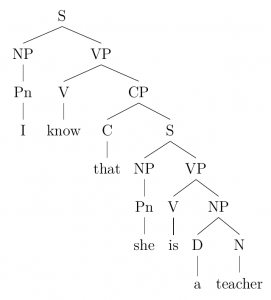
Figure 6. (4b) Syntax Tree
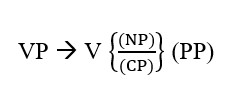
Figure 7. Verb Phrase Structure Rule
(5) That waffles are good is true.
Example (5) reveals that CPs can also act as the subject of a sentence which must be accounted for within the phrase structure rules. The S → NP VP rule can be changed to allow the option of a CP instead of an NP just as in the verb phrase rule.

Figure 8. Sentence Phrase Structure Rule
Both (4a) and (4b) show that in English, a sentence that is within a complementizer phrase has the same word order, SVO, as any normal English sentence. However, this is where German and English are strikingly different. German’s embedded clauses are in fact not SVO like its main clauses, instead they are SOV. At first, one might consider this to be a problem because it is hard to fathom why German would be SOV in its embedded clauses but not anywhere else. However, the solution that is proposed by generative grammar is that this SOV structure is the deep structure and basis for all sentences in German, not just embedded clauses. Thus, German is actually an SOV language and various transformation rules are applied to change its deep structure word order to its surface level word order (Vickner 1995). This is what leads to German being commonly thought of as an SVO language.[1]
From that, a grammar for German can start to be constructed. It is important to note that the phrase structure rules that are being created at first are only applicable to the embedded clauses themselves that appear in these examples, not the sentence as a whole. These same rules will then be used to derive the surface structure of main clauses later.
(6a) Ich glaube, dass Hans studiert.
I believe that Hans studies
‘I believe that Hans is studying.’
(6b) Ich glaube, dass er in Berlin wohnt.
I believe that he in Berlin lives
‘I believe that he lives in Berlin.’
(6c) Ich glaube, dass sie einen Sohn haben.
I believe that they a son have
‘I believe that they have a son.’
(6d) Dass die Kinder ein fremdes Mädchen nach Hause bringen, stört mich.
That the children a strange girl to home bring disturbs me
‘That the children are bringing a strange girl home disturbs.’
The examples above show different German sentences, with the second line being the direct word for word translation into English. From that, it is then possible to devise the phrase structure rules for CPs and the sentences that exist within them. All of the examples contain the C, dass, followed by a sentence, making up the CP which then appears as CP → C S. As for the sentence structure within the embedded clauses, it appears to require an NP followed by a VP such as S → NP VP. Example (6d) also reveals that a CP can occur instead of an NP within the overall sentence. Both are noticeably the same as English.
Now that it is known that there is an NP and VP that comprise these sentences, the individual phrase structure rules for these constituents can be established. Starting with the NP, examples such as (6c) exhibits that a D often comes before the main N. Example (6d), on the other hand, shows the use of an A, fremdes, ‘strange/foreign’, which is occurring after the D but before the main N. Moreover, instead of just a rule stating NP → (D) (A) N, PNs and names also need to be an option. Since none of the PNs or names cooccur with a D or A in examples such as (6a) and (6b), the rule would then look like how it is shown below.[2]
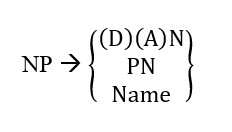
Figure 9. German Noun Phrase Structure Rule
Moving on to the VP, there is evidence of a PP in examples such as (6b) and (6d). Within the PP itself, it appears that the preposition (P) is occurring before the NP. However, as for its relation to the V, the PP appears to directly precede the main V. This is demonstrated in example (6b) with in Berlin wohnt meaning ‘lives in Berlin’. However, using a word for word translation to English, it would be ‘in Berlin lives’, demonstrating how the PP is being placed directly before the main V. Example (6d) illustrates this as well but leads to the discovery of where the NP should be placed in relation to both the PP and V. In this case, the NP, ein fremdes Mädchen, ‘a strange girl’ is occurring before the PP and V, nach Hause bringen ‘are bringing home.’ Since ein fremdes Mädchen is the object of the V and is what the children are bringing home, this NP must fit within the VP at the very beginning, preceding the PP and the main V. It is also possible to state that both of these are optional given that example (6a) is a grammatical sentence. Thus, the newly formed verb phrase structure rule is presented below including the other rules that have been generated so far that also demonstrate the structure of embedded clauses in German.
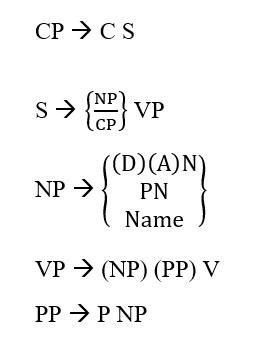
Figure 10. German Phrase Structure Rules
The next set of examples introduces new verbal elements that need to be added to the phrase structure rules that have been created so far.
(7a) Es ist traurig, dass alle Menschen sterben müssen.
It is sad that all men die must
‘It is sad that all men must die.’
(7b) Dass die Kinder nach Berlin gefahren sind, ist klar.
That the children to Berlin gone have is clear
‘That the children have gone to Berlin is clear.’
(7c) Er weiß, dass wir das Haus gesehen haben müssen.
He knows that we the house seen have must
‘He knows that we must have seen the house.’
(7d) Es ist unglaublich, dass er angekommen sein könnte.
It is unbelievable that he arrived have could
‘It is unbelievable that he could have arrived.’
These new additions such as, müssen ‘must’, sind ‘be’, haben ‘have’, and könnte ‘could’, operate as auxiliary verbs, AUX. However, there is a further distinction that can be made between them. While verbs like haben and sind can be placed in the same category, müssen and könnte can be categorized as modal verbs, MOD, a type of AUX that expresses necessity or possibility (see also Felt, this issue). In order to understand where they occur in relation to the main V and how they interact with each other, the aforementioned examples must be further analyzed. Looking at example (7a), it appears that the MOD, müssen, is appearing directly after the main V. This can also be seen in (7b) with sind. However, both examples (7c) and (7d) show that either haben or sind can exist before a MOD. This order allows for a main V followed by an optional AUX and optional MOD.

Figure 11. German Verb Phrase Structure Rule
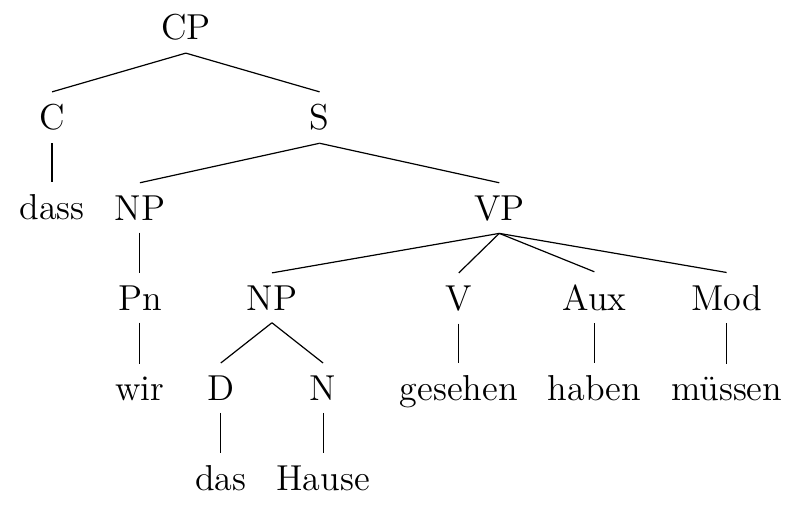
Figure 12. (7c) Syntax Tree
The basics of the phrase structure rules have been constructed and now negation will be included. Examples of German sentences that include a negator are shown.
(8a) Ich glaube, dass die Kinder nicht nach Berlin gefahren sind.
I believe that the children not to Berlin go have
‘I believe that the children did not go to Berlin.’
(8b) Ich glaube, dass der Professor nicht Fußball gespielt hat.
I believe that the Professor not soccer played has
‘I believe that the professor has not played soccer.’
(8c) Ich denke, dass die Kinder nicht einen Affen nach Hause bringen sollen.
I think that the children not a monkey to Home bring should
‘I think that the children should not bring a monkey home.’
The negator nicht is being inserted, and by noticing the pattern presented in each of the examples, the presumption that nicht is included in the VP and before both the NP and PP is true, as seen in example (8c). Nicht is appearing before the direct object NP, einen Affen ‘a monkey’, which usually comes first within the VP as seen in the previous rules that have already been generated. Thus, the new rule for VPs in German is an optional negator (NEG) followed by the same order of constituents.
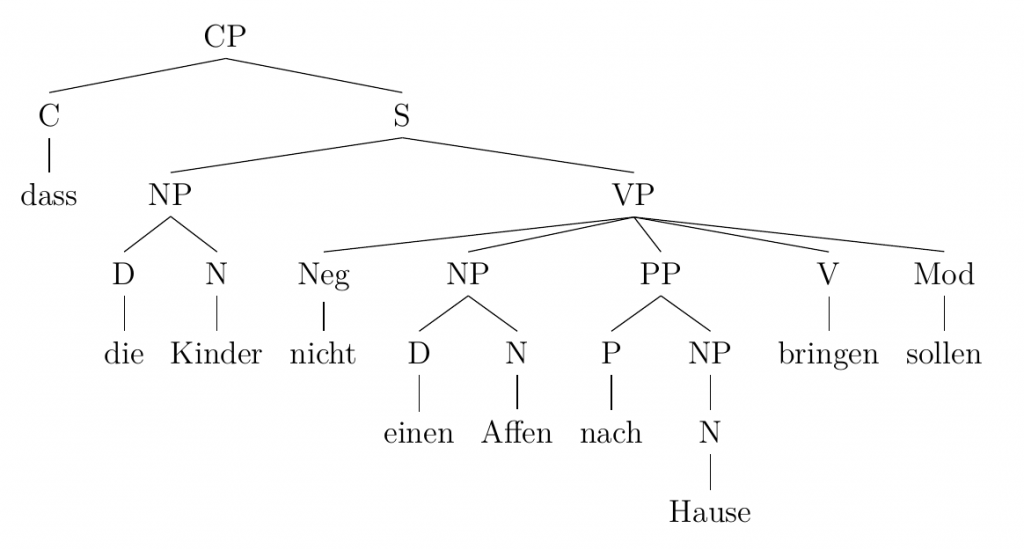
Figure 13. (8c) Syntax Tree

Figure 14. German Verb Phrase Structure Rule with Negator Included
Up until now, only the structure that occurs within embedded clauses has been analyzed and no transformations have been implemented. However, the next few examples introduce yes-no questions in German main clauses, which requires a transformation rule in order to derive the surface level structure.
(9a) Fahren die Kinder nach Berlin?
Going the children to Berlin
‘Are the children going to Berlin?’
(9b) Haben sie nicht einen Sohn?
Have they not a son
‘Don’t they have a son?’
(9c) Müssen alle Menschen sterben?
Must all Men die
‘Must all men die?’
From the previous analysis of German that has been done so far, along with the phrase structure rules that have been developed, it is known that within the VP, a main V exists along with an optional AUX and optional MOD. However, in the examples (9a-c), the verbs are noticeably being moved around. Example (9a) only contains one V, fahren ‘going’, and it is now at the beginning of the sentence. However, both (9b) and (9c) contain a main V and either an AUX or MOD. In these cases, the rightmost V appears to be the one that is being relocated to the beginning of the sentence, making it into a yes-no question. This can best be expressed by a transformation rule which can be called Verbal Fronting similar to Subject Auxiliary Inversion in English where the leftmost AUX moves to the front, as in Are the children __ driving to Berlin? This rule is described below along with syntax trees exhibiting this new transformation.
(10) Verbal Fronting: Take a S and move the rightmost verbal element to the front.
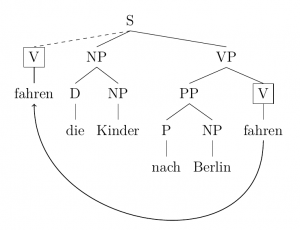
Figure 15. (9a) Syntax Tree with Verbal Fronting Breakdown
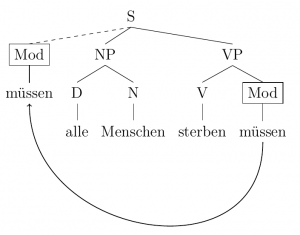
Figure 16. (9c) Syntax Tree with Verbal Fronting Breakdown
It is now feasible to analyze simple declarative sentences in German. It will become clear that it is most efficient to consider the structure of the embedded clause, that has been the basis of the phrase structure rules thus far, to be the deep structure of German, so that the surface structure of main clauses will be derived from the embedded clause structure.
(11a) Einen Affen bringen die Kinder nach Hause.
A monkey bringing the children to home
‘The children are bringing a monkey home.’
(11b) Die Kinder sind nicht nach Berlin gefahren.
The children are not to Berlin go
‘The children didn’t go to Berlin.’
(11c) Der Professor hat das Buch gelesen.
The professor has the book read
‘The professor has read the book.’
(11d) Nach Hause müssen die Kinder einen Affen gebracht haben.
To home must the children a monkey bring have
‘The children must have brought a monkey home.’
Previously, a verbal-fronting rule was conceived that was used to create yes-no questions in German. However, upon examining the examples (11a-d), this same rule seems to be applying here before another rule. As shown above, (11c) still has the main V, gefahren ‘go’, at the end of the sentence, but the AUX, sind,is not placed behind it as is it should be according to the phrase structure rules. As such, it can be assumed that verbal fronting occurred meaning the sentence previously looked like Sind Die Kinder nicht nach Berlin gefahren. Consequently, it is evident that Die Kinder was then fronted to end up in the initial slot before the previously fronted AUX. The same happens in all of examples (11), the only difference being the phrase that is fronted in the second step. In (11b), the object NP is fronted, while in (11d) the PP is being fronted. It stands to follow that, what is being fronted must be a constituent, or phrase, of the S or VP. This rule is articulated below along with syntax trees to illustrate it.
(12) Constituent-fronting: Take an S that has already undergone verbal fronting and move a constituent of the S or VP to the front of sentence.
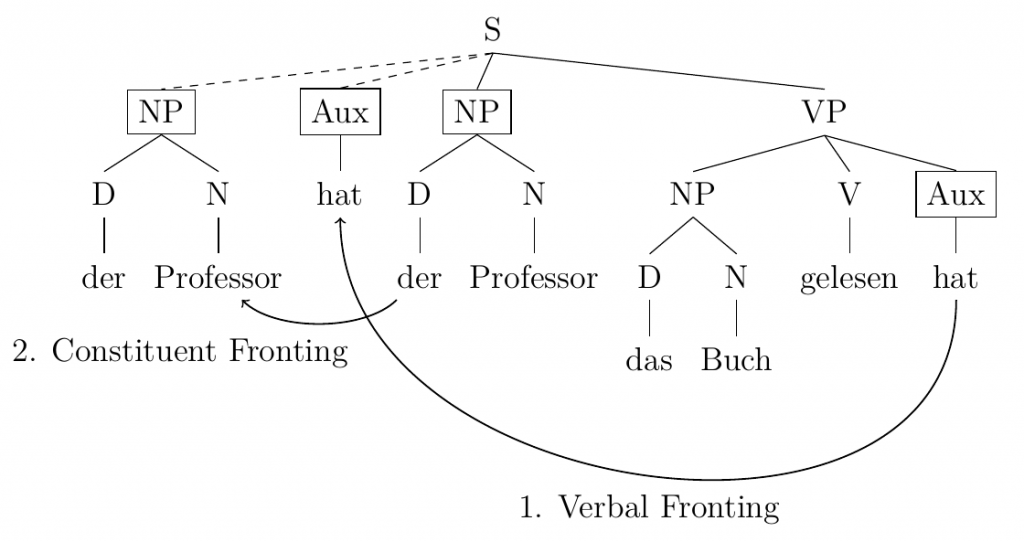
Figure 17. (11c) Syntax Tree with Verbal Fronting and Constituent Fronting Breakdown
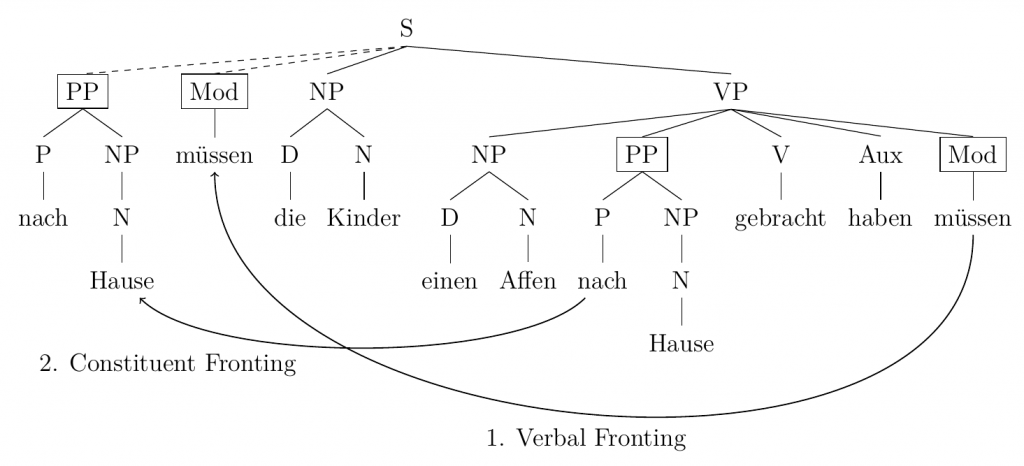
Figure 18. (11d) Syntax Tree with Verbal Fronting and Constituent Fronting Breakdown
Both verbal and constituent fronting illustrate how the SOV deep structure of German is transformed into the more familiar SVO surface structure that people know at least given examples like (11c). Notice that, if German was understood to have an underlying SVO structure like English, two or even three verbal elements would have to move from the front to the back of the sentence in embedded clauses, and one or two in main clauses whenever a sentence has more than a singular verbal element. With this understanding, it is reasonable to assume that starting with SVO is less efficient than starting with SOV and simply moving the right most verbal element to the front.
As seen from this analysis of German phrase structure, the surface structure and deep structure are remarkably different. It is important to note that while German can present as SVO in its surface structure, there are plenty of cases where it is still not SVO even in its most derived form which can be seen with both the verbal and constituent fronting rules that have been generated. If there is more than one verbal element when a V gets fronted, there will still be a V remaining at the end of the clause, taking away from German’s supposed SVO word order status. In addition, “SVO” is not a fitting description when a constituent that is not the subject is fronted in the second step of the constituent fronting transformation, after verbal fronting. This is why German main clause word order is described by linguists as “verb-second” or “V2”, which does not specify what constituent ends up in initial position.
This is what makes German and English quite distinct. As mentioned in Speyer’s (2010) book, topicalization as seen in the constituent fronting rule is not nearly as common in English. Moreover, when a question is being formed with an auxiliary moving to the front of the sentence, the main verb can never be fronted in English. Thus, despite German and English coming from the same language family and being closely related, their word order and overall deep structure greatly varies from each other. However, when taking into consideration the theory of generative grammar and the phrase structure rules that emerge from it, many of the rules, such as for the S and NP, are noticeably still the same in both languages.
This type of surface level comparison is what makes it easy for anyone to assume that German and English are more similar than they actually are. Thus, somewhat unexpectedly, understanding the structure of German’s embedded clauses is the key that unlocks a new linguistic world that is not easily visible. Through different phrase structure and transformation rules, the deep structure of German, which shows a different picture than what was previously imagined, is then forged into another structure entirely. Consequently, when using generative grammar as a guide, any language can be analyzed in this manner, which can uncover even more unlikely hidden linguistic structures.
References
Chomsky, Noam. 1964. Current issues in linguistic theory. The Hague: Mouton.
Chomsky, Noam. 1965. Aspects of the theory of syntax. Cambridge, Massachusetts: MIT Press.
Dikken, Marcel den. 2013. The Cambridge Handbook of Generative Syntax. Cambridge Handbooks in Language and Linguistics. Cambridge: Cambridge University Press.
“Germanic Languages.” 2020. Columbia Electronic Encyclopedia, 6th Edition, 1–2.
Fagan, Sarah M. B. 2009. German: A Linguistic Introduction. Cambridge, UK: Cambridge University Press.
Speyer, Augustin. 2010. Topicalization and Stress Clash Avoidance in the History of English. Berlin: De Gruyter Mouton.
Vikner, Sten. 1995. Verb Movement and Expletive Subjects in the Germanic languages. New York and Oxford: Oxford University Press.
Notes
[1] As we will see, German main clause word order only resembles SVO when the subject acts as a topic and when there is only one verbal element.
[2] Names in German can actually be modified by a determiner, but this fact is abstracted away from here.
Acknowledgements: I would like to thank the editors for their assistance in my writing of this paper, along with Dr. Lee-Schoenfeld for her continual support in class and in the whole process of submitting and revising for this paper.